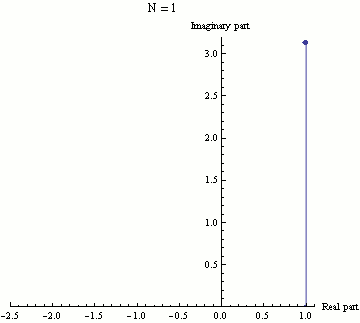
Euler’s identity
e^{i \pi} + 1 = 0
Euler’s identity is considered by many to be remarkable for its mathematical beauty. These three basic arithmetic operations occur exactly once each: addition, multiplication, and exponentiation. The identity also links five fundamental mathematical constants:
- The number 0, the additive identity.
- The number 1, the multiplicative identity.
- The number π, which is ubiquitous in trigonometry, the geometry of Euclidean space, and analytical mathematics (π = 3.14159265…)
- The number e, the base of natural logarithms, which occurs widely in mathematical and scientific analysis (e = 2.718281828…). Both π and e are transcendental numbers.
- The number i, the imaginary unit of the complex numbers, a field of numbers that contains the roots of all polynomials (that are not constants), and whose study leads to deeper insights into many areas of algebra and calculus, such as integration in calculus.
Furthermore, in algebra and other areas of mathematics, equations are commonly written with zero on one side of the equals sign.
A poll of readers conducted by The Mathematical Intelligencer named Euler’s identity as the “most beautiful theorem in mathematics”. Another poll of readers that was conducted by Physics World in 2004 chose Euler’s identity tied with Maxwell’s equations (of electromagnetism) as the “greatest equation ever”.
An entire 400-page mathematics book, Dr. Euler’s Fabulous Formula (published in 2006), written by Paul Nahin (a professor emeritus at the University of New Hampshire), is devoted to Euler’s identity, especially its applications in Fourier Analysis. This monograph states that Euler’s identity sets “the gold standard for mathematical beauty”.
Constance Reid claimed that Euler’s identity was “the most famous formula in all mathematics”.
The mathematician Carl Friedrich Gauss was reported to have commented that if this formula was not immediately apparent to a student upon being told it, that student would never be a first-class mathematician.
After proving Euler’s identity during a lecture, Benjamin Peirce, a noted American 19th-century philosopher, mathematician, and professor at Harvard University, stated that “it is absolutely paradoxical; we cannot understand it, and we don’t know what it means, but we have proved it, and therefore we know it must be the truth.”
Stanford University mathematics professor Keith Devlin said, “Like a Shakespearean sonnet that captures the very essence of love, or a painting that brings out the beauty of the human form that is far more than just skin deep, Euler’s Equation reaches down into the very depths of existence.”
Oh, and Happy Primes
7, 13, 19, 23, 31, 79, 97, 103, 109, 139, 167, 193, 239, 263, 293, 313, 331, 367, 379, 383, 397, 409, 487
